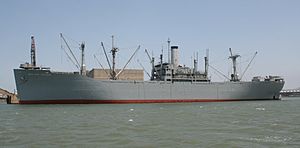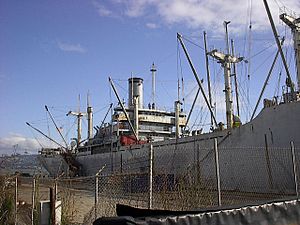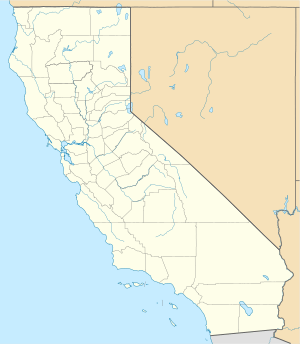SS Red Oak Victory facts for kids

SS Red Oak Victory
|
|
| History | |
|---|---|
| Name | Red Oak Victory |
| Namesake | The city of Red Oak, Iowa |
| Builder | Permanente Metals Corporation, Richmond, California |
| Yard number | Yard No.1 |
| Laid down | 9 September 1944 |
| Launched | 7 November 1944 |
| Acquired | 5 December 1944 |
| Commissioned | 5 December 1944 |
| Decommissioned | 21 May 1946 |
| Out of service | 19 December 1969 |
| Stricken | 19 July 1946 |
| Identification |
|
| Fate | Released from the National Defense Reserve Fleet, 19 September 1998 for restoration at the Richmond, California, Museum of History |
| Status | Museum at Richmond, California |
| General characteristics | |
| Class and type | Boulder Victory-class cargo ship |
| Displacement |
|
| Length | 455 ft (139 m) |
| Beam | 62 ft (19 m) |
| Draft | 29 ft 2 in (8.89 m) |
| Installed power | 6,000 shp (4,500 kW) |
| Propulsion |
|
| Speed | 15.5 kn (17.8 mph; 28.7 km/h) |
| Complement | 99 officers and enlisted |
| Armament |
|
|
SS Red Oak Victory
|
|

SS Red Oak Victory as seen from the dock in 2006, before extensive restoration work was performed
|
|
| Location | Richmond, California |
| Built | 1944 |
| NRHP reference No. | 00001674 |
| Added to NRHP | 30 January 2000 |
The SS Red Oak Victory is a special kind of cargo ship called a Victory ship. These ships were very important during World War II. The Red Oak Victory helped carry supplies for the United States.
Today, this ship is a museum ship in Richmond, California. It is managed by the Richmond Museum of History. You can find it near the Rosie the Riveter/World War II Home Front National Historical Park.
The Red Oak Victory was one of 534 Victory ships built during World War II. It was one of the few that served in both the United States Merchant Marine and the United States Navy. The ship was named after Red Oak, Iowa, a city that lost many people in early World War II battles. This ship was active during World War II, the Korean War, and the Vietnam War.
Contents
Building a Victory Ship
The Red Oak Victory was built in Richmond, California. It was constructed by the Permanente Metals Corporation at their Richmond Number 1 Yard. The ship was launched on November 9, 1944.
This large ship is about 455 feet long. That's longer than a football field! It was armed with several guns to protect itself. These included a five-inch gun, a three-inch gun, and eight smaller 20 mm guns.
Serving in World War II
The United States Navy took control of the ship on December 5, 1944. It was then called USS Red Oak Victory (AK-235). After getting ready, the ship loaded up with cargo. It left San Francisco for Pearl Harbor on January 10, 1945.
On February 10, the Red Oak Victory left Hawaii. It carried important munitions (ammunition and supplies) to islands like the Marshall Islands and Caroline Islands. It then went to Ulithi and worked with Commander Service Squadron Ten.
The ship operated from the Philippines, delivering cargo and ammunition to many fleet ships. It continued this vital work until the war ended in August 1945. The Red Oak Victory handled tons of ammunition in the Pacific. It supplied the fleet safely without any crew members being hurt.
Later Years and Museum Life
After World War II, the Red Oak Victory was taken out of Navy service in 1946. It was returned to the U.S. Maritime Commission. From 1947 to the 1950s, the Luckenbach Steamship Company used the ship. It traveled to many countries, including Japan, Korea, Cuba, and India.
From 1966 to 1968, American Mail Lines operated the ship for the Military Sea Transport Service. During this time, it made about a dozen trips. It carried military supplies to Vietnam, Japan, and the Philippines. These supplies were loaded at ports on the West Coast of the United States.
From 1968 until 1998, the ship was stored in the National Defense Reserve Fleet. This fleet is located in Suisun Bay, California. The ship was going to be scrapped, which means taken apart for its materials.
However, the Richmond Museum Association became interested in the ship in 1993. In 1996, the United States Congress passed a law. This law allowed the ship to be given to the Museum Association.
On September 20, 1998, the Red Oak Victory was moved to its new home. It was towed to Richmond Shipyard 3. This is close to where it was originally built in 1944. The Richmond Museum of History is now restoring and operating the ship. It is also connected to the Rosie the Riveter/World War II Home Front National Historical Park.
Images for kids
See also




